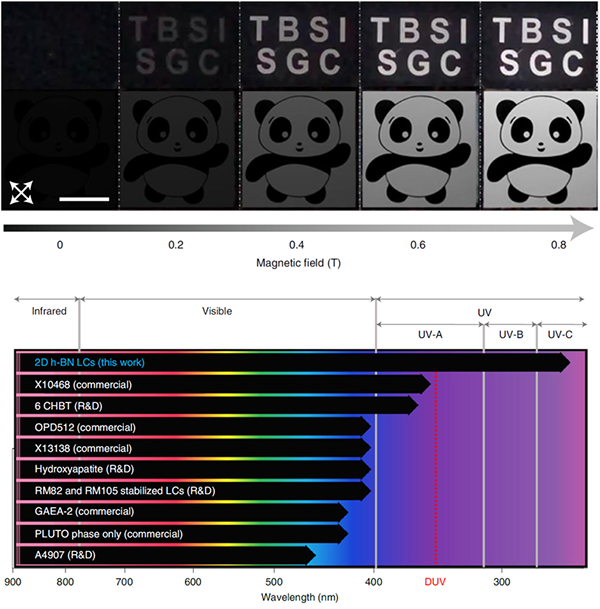
Figure. Magneto-optical birefringence effect of 2D h-BN LC and the comparison of commercialized and research and development (R&D) LC-based optical modulators
Supported by the National Natural Science Foundation of China (Grant No. 51920105002, 52125309, and 52188101), the research team led by Prof. Bilu Liu from Shenzhen International Graduate School of Tsinghua University, in collaboration with the research team led by Prof. Baofu Ding and Prof. Hui-Ming Cheng from the Institute of Technology for Carbon Neutrality of Shenzhen Institute of Advanced Technology, Chinese Academy of Sciences, and the team led by Prof. Dahai Wei from the Institute of Semiconductors, Chinese Academy of Sciences, have made new progress in magnetically tunable and stable deep-ultraviolet (DUV) birefringent optics. They have revealed the giant magneto-optical Cotton-Mouton effect and its underlying physics of inorganic two-dimensional (2D) hexagonal boron nitride (h-BN) liquid crystal, and fabricated DUV LC modulator with high stability in the solar-blind UV-C spectral region. The research was published in Nature Nanotechnology on August 11, 2022, with the title “Magnetically tunable and stable deep-ultraviolet birefringent optics using two-dimensional hexagonal boron nitride”. (Article link: http://doi.org/10.1038/s41565-022-01186-1). In addition, Dr. Alberto Moscatelli, the chief editor of Nature Nanotechnology, and Prof. Michael Kneissl from Technische Universität Berlin, Germany, provided professional comments on a Research Briefing paper published in the same issue, entitled “A 2D material-based liquid crystal for deep-ultraviolet light modulation”. (Article link: http://doi.org/10.1038/s41565-022-01192-3).
Optical modulation technology is capable for controlling the amplitude, frequency, polarization or phase retardation of an input optical signal, which is widely used in optical communication, display and other disciplines. LC optical modulator based on birefringence effect plays a key role in transmitted-type optical modulation, the annual global market of which exceeds hundreds of billion dollars. At present, the LC modulator mostly works in the visible or infrared spectral regions, while there is still a huge challenge to fabricate LC modulator that stably works in DUV range. The polymeric LC molecules are highly likely to be destroyed by UV irradiation and thus cause the device failure. Although some inorganic crystals can serve as DUV-transparent birefringent media, their birefringence is fixed and cannot be tuned via an external stimulus. Accordingly, these problems restrict the development of DUV modulation techniques and the applications of continuous modulation devices for UV and DUV light.
The research team proposed a stable DUV modulator with magnetically tunable birefringence based on a six-membered-ring material 2D h-BN with a wide band gap (>6 eV) and a large intrinsic optical anisotropy factor. The dispersion of 2D h-BN is an inorganic lyotropic LC, where the 2D h-BN tends to align along the direction of magnetic field. The ordered alignment introduces the optical anisotropy, namely the birefringence, of 2D h-BN liquid crystal, the degree of which can be sensitively tuned by magnetic field (Figure). Quantitative analyses reveal a giant Cotton-Mouton effect of 2D h-BN liquid crystal with a record-high Cotton-Mouton coefficient of 8.0 × 106 T-2m-1, representing a five orders of magnitude improved sensitivity than other DUV-transparent or potential DUV-transparent birefringent media. The observed giant Cotton-Mouton effect was ascribed to the geometric feature of 2D materials with an extremely large aspect ratio and the intrinsic large optical anisotropy of h-BN (optical anisotropic factor Δg, up to 7.0×10-12 C2J-1m-1). Moreover, a transmitted-type modulator for UV-C light with magnetically tunable birefringence was fabricated using as-investigated 2D h-BN LC. The 2D h-BN LC modulator showed good stability when used to tune the DUV light at a wavelength of 266 nm.
This work can extend the widely-used birefringent optics in the visible and infrared spectral region into the DUV range, contributing to potential applications in many fields, such as UV-C communication, sophisticated lithography, and high-density information storage.

Add: 83 Shuangqing Rd., Haidian District, Beijing, China
Postcode: 100085
Tel: 86-10-62327001
Fax: 86-10-62327004
E-mail: bic@donnasnhdiary.org
京ICP备05002826号 文保网安备1101080035号 Copyright 2017 NSFC, All Right Reserved